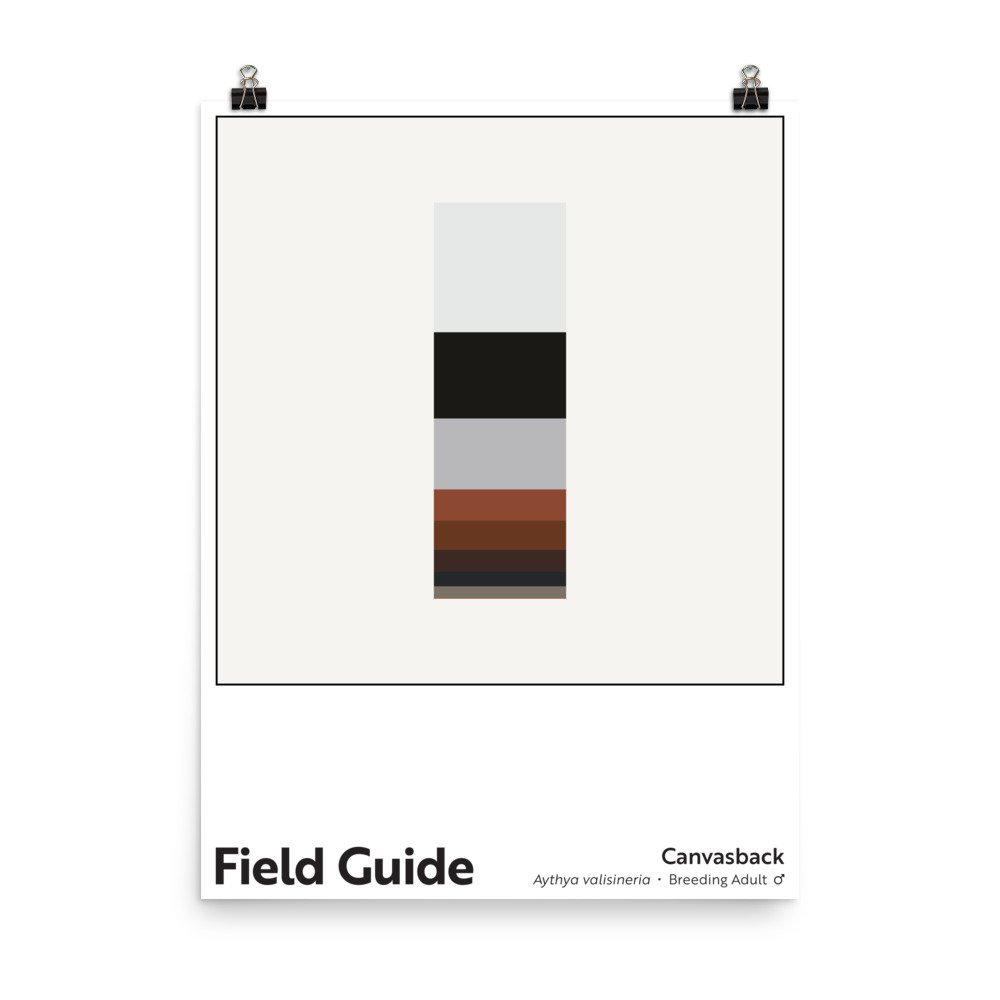Field Guide : Canvasback (Male)
Field Guide : Canvasback (Male)
Unlimited edition. 18 x 24 inch, museum-quality poster on matte paper.
I call this fine bird a canvasback or “can,” but it has some impressive epithets, including “the king of ducks” and “the aristocrat.” These names originate in the restaurant business; the canvasback is considered an especially tasty addition to the dining table, but the drake’s distinctive profile, handsome simplicity, and relatively large size also give rise to the bird’s exceptional reputation.
The male canvasback’s bold blocks of color stand out – the rich chestnut and chocolate of his head and neck, deep charcoal of his chest and rump, and back and sides delicately worked with silver and snow. This distinctive coloring coupled with the canvasback’s long, sloping forehead and bill make for one rakish drake. Early European Americans took note of the dashing, delicious duck, and by the middle of the 1800s, the bird was a prestigious game dish served at the country’s finest restaurants and banquets. Predictably, the prized (and highly valued 💸) canvasback became a prime target for market hunters and, by the end of the century, the species had become "scarce, expensive, or unobtainable.” Fortunately, some hunter-conservationists of the day noticed that populations of waterbirds were reeling from the combination of habitat loss and the myopic, kill-them-all-for-today’s-pay-day approach of market hunters, and they resolved to take action. The reforms they managed to pass represent major victories for the then-nascent conservation movement and, importantly, allowed many waterbird and shorebird populations to recover. Today, the canvasback population is robust and stable, and the species has been deemed of “low conservation concern.”
The canvasback is the largest North American diving duck, and it occurs exclusively on the continent, with a range that extends from Alaska to Mexico. Like other diving ducks – as the category name suggests – the canvasback principally feeds by diving to grab tubers, roots, snails, and insect larvae from the floor of the lakes, marshes, bays, and ponds where it congregates. Researchers learned that 80% of the canvasback’s general diet is composed of vegetable matter. Wild celery (Vallisneria americana) is one of the plants favored by canvasbacks during the winter, and the species piece of the canvasback’s scientific binomial, valisineria, is a nod to the plant. (The genus piece of the binomial, Aythya, just translates as “sea bird,” so the full translation of Aythya valisineria is something along the lines of “celery-loving sea bird” – “aristocrats” love celery, right?)
Note: These archival poster prints feature rich, appealing colors. I encourage customers to take care in handling them until they are framed/protected for display; the darker colors on the matte paper can be scratched. They ship rolled, so customers need to flatten them before framing (or have their framer do so).
Charitable Sales Model: Whenever one of these poster prints is purchased, a charitable contribution equal to 10% of the print’s cost (or $3.60) is made to a nonprofit working to tackle environmental or social challenges. Read more about my charitable sales model here.

